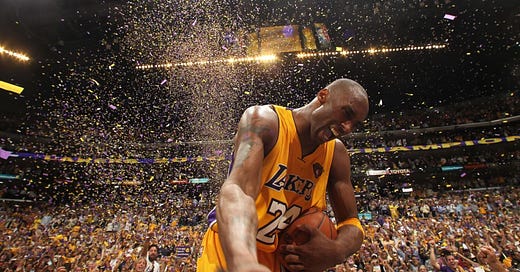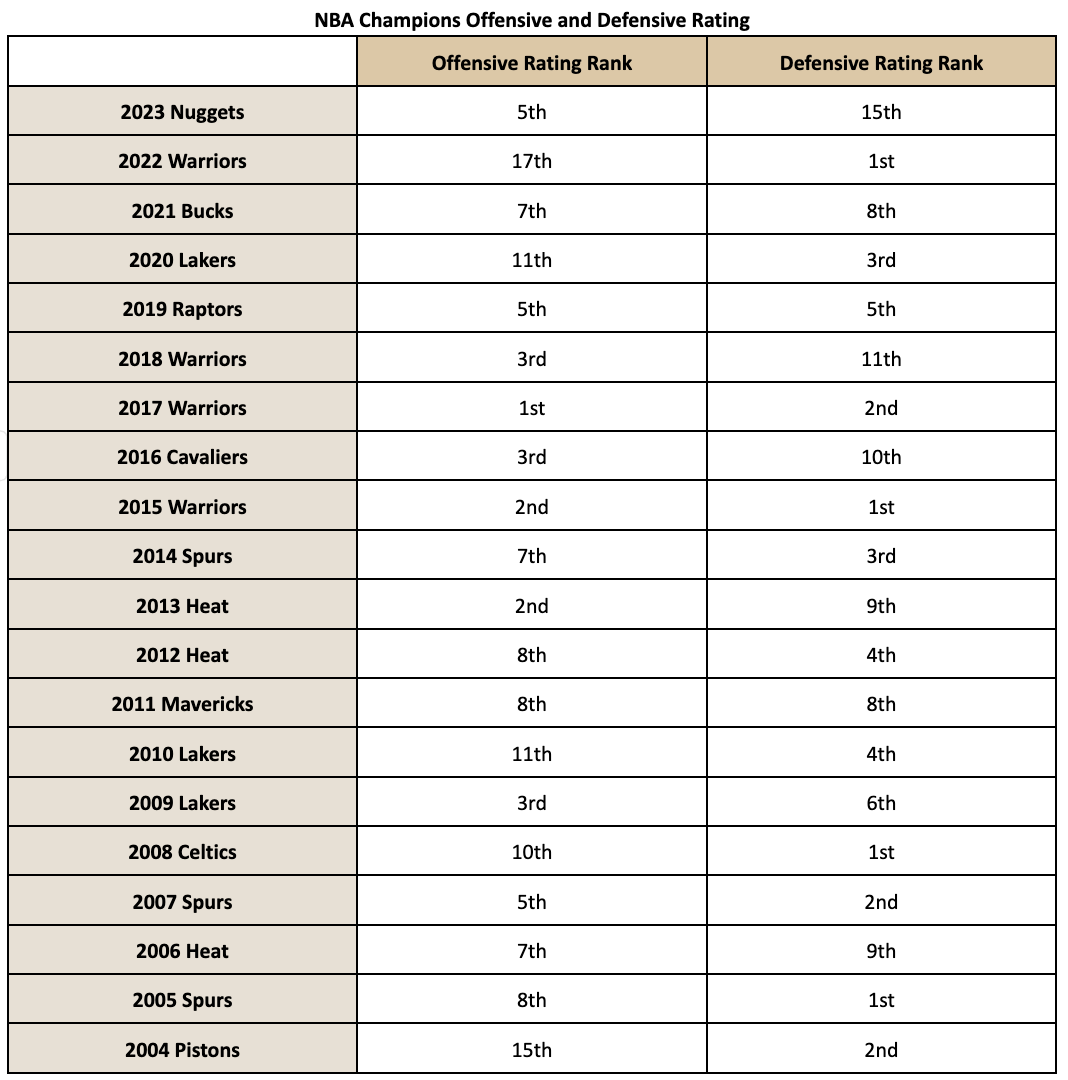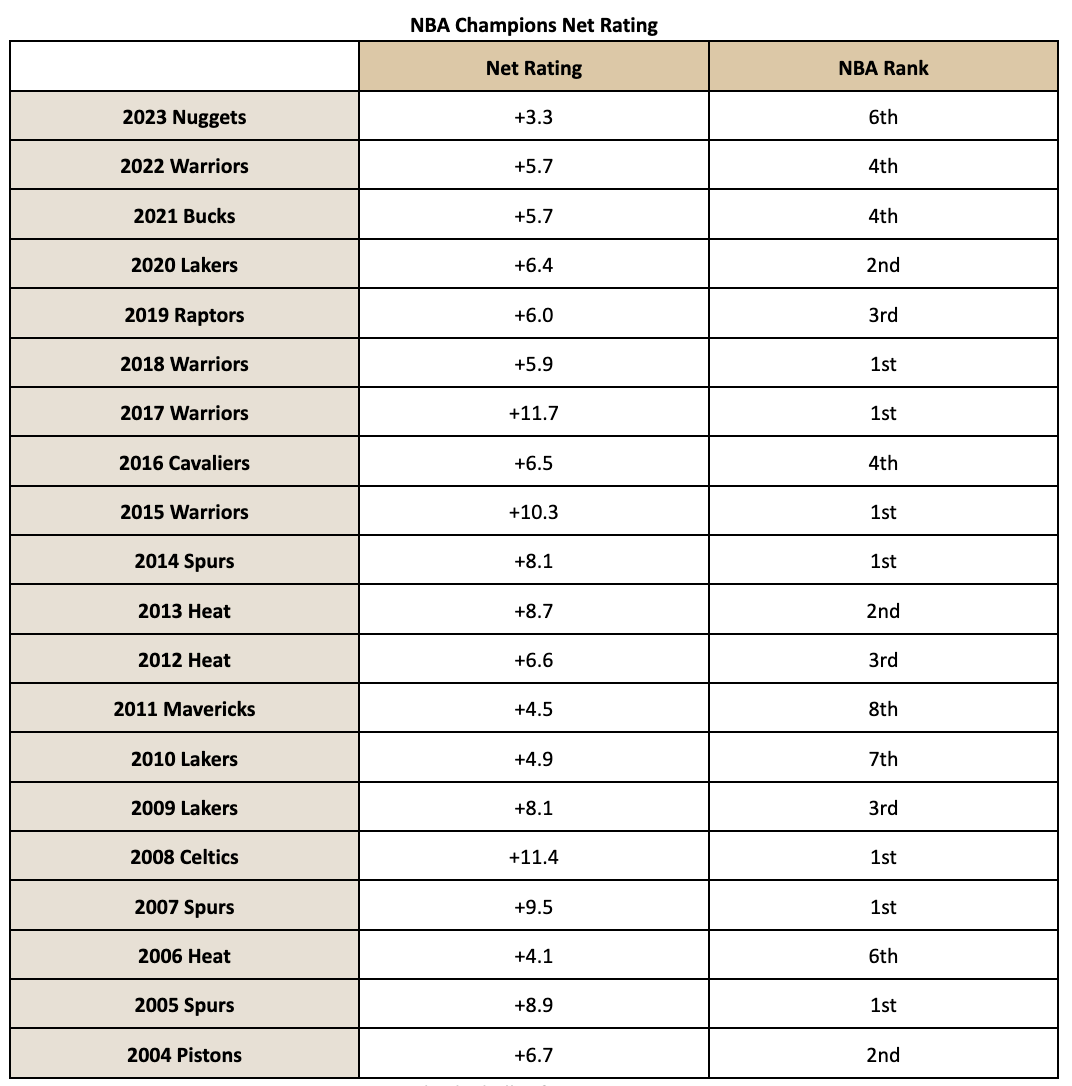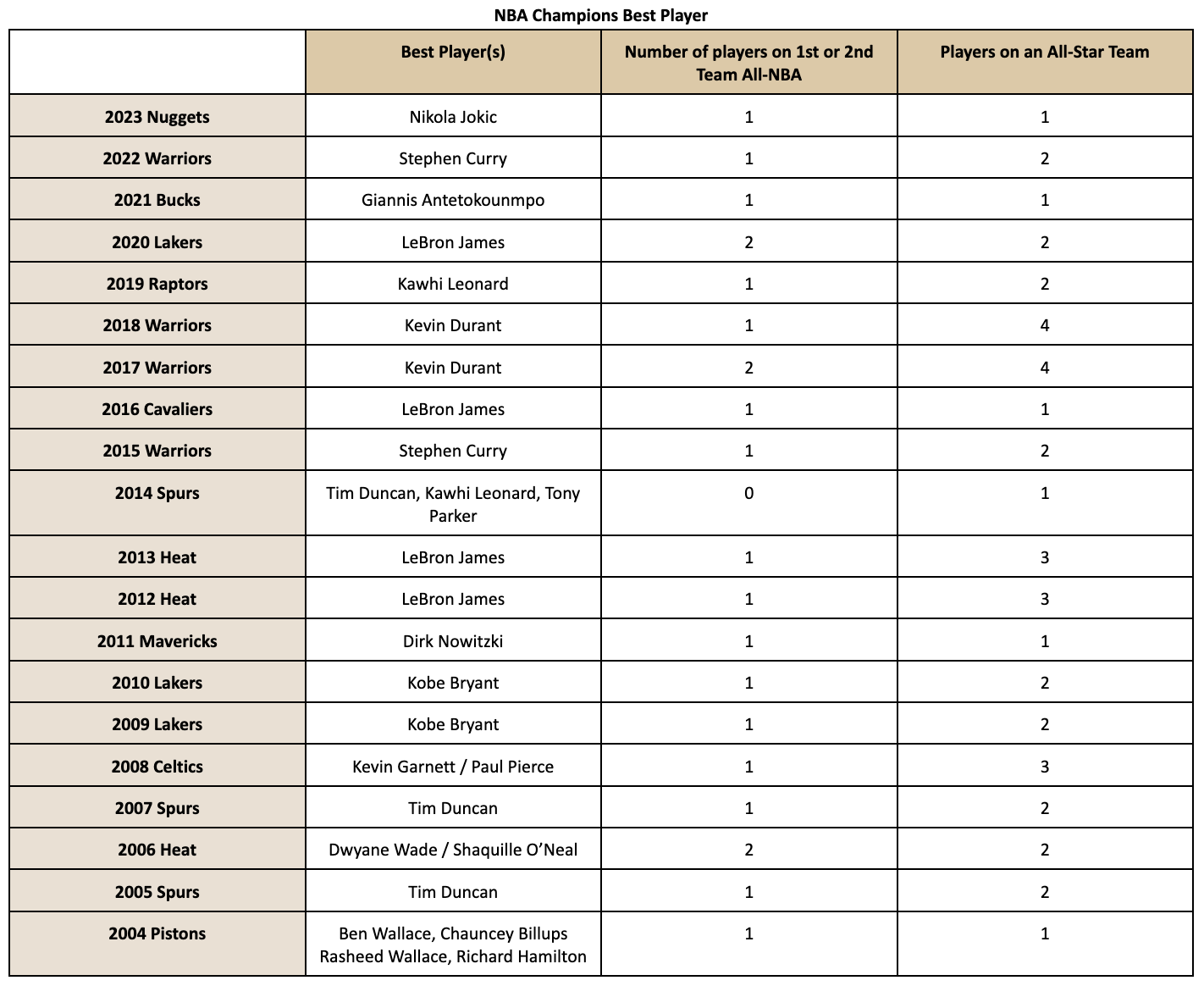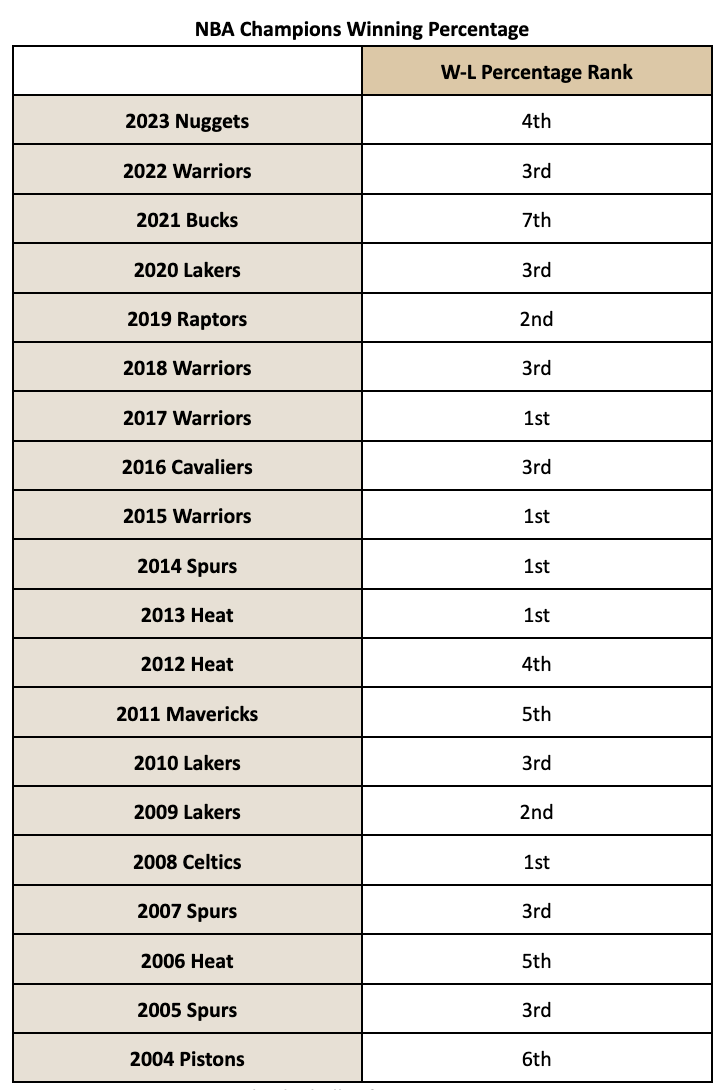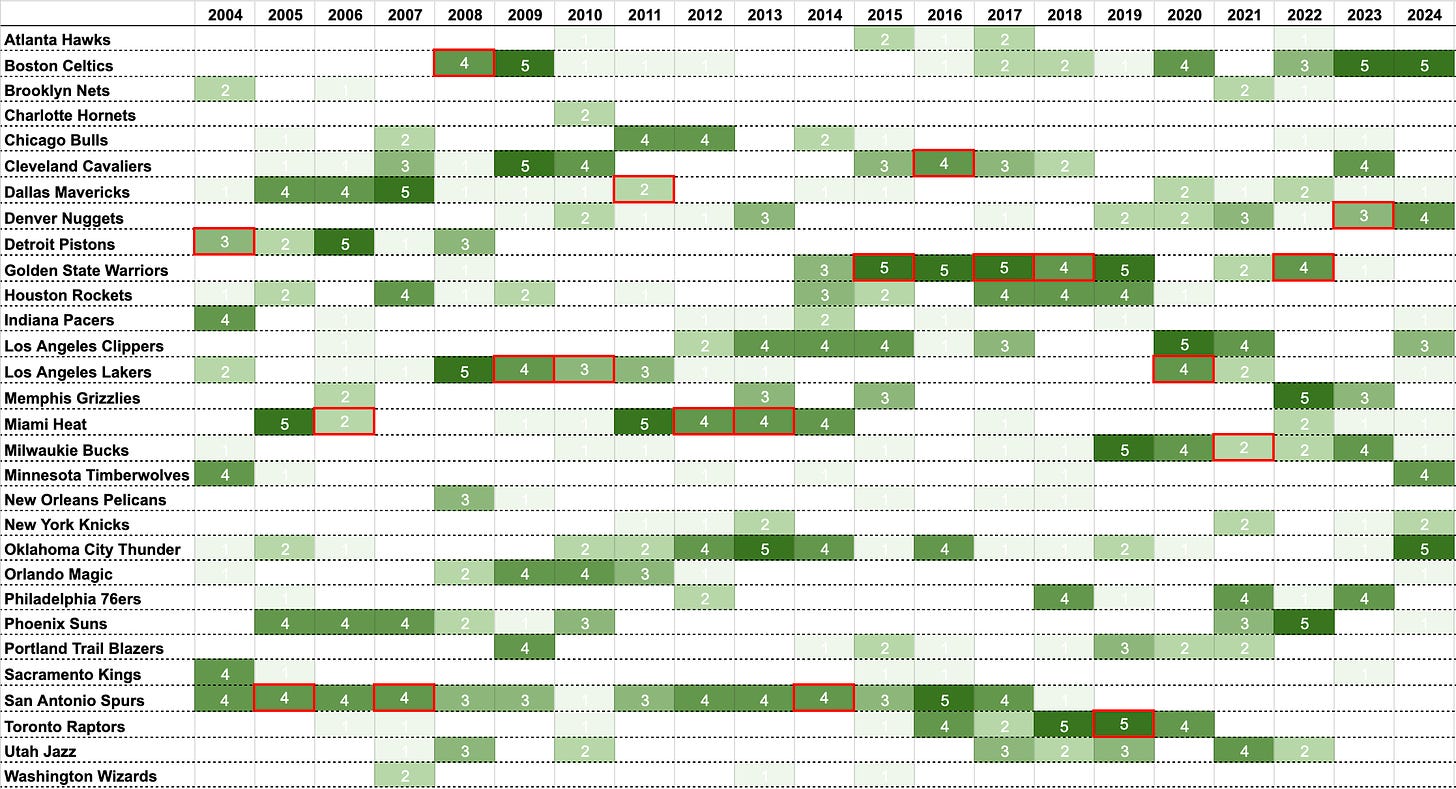How to Predict When a Championship Window is Open
A guide on identifying NBA championship contenders
The road to an NBA championship is often long, windy, and filled with potholes and steep climbs. When a championship window opens, it only opens up long enough to quickly reach out and grab the trophy before it comes down on your hand in a painful fashion.
To win a championship, everything has to go right, with a sprinkling of luck. Championship teams have to avoid the injury bug at the most inopportune times. They must have a coach who can adjust on the fly to gain every advantage imaginable over their opponent. In the offseason, before a championship run, a GM has to ensure that salaries match the potential championship timelines of a team before the salary cap is blown right off. Mid-season moves often need to be made to give the team a slight upgrade heading into the playoffs. The whistle has to go your way, and the ball needs to bounce just right.
If any of these things go wrong, it can set a team back for years with the violent closing of the championship window.
But how do you know when your championship window is open? How long does it stay open? And what can front offices do to extend a championship window for as long as possible?
It's easier to answer these questions in hindsight, but there is some historical evidence we can examine to help determine if a team does have its championship window open. To unpack these questions, we must first answer what makes a championship team.
Championship Team Indicators
I looked at the stats of all the championship teams over the past 20 years. The following are key indicators many championship teams possess:
Dominant: Top 5 offensive or defensive rating
Balanced: Top 5 net rating
Star Talent: Top 10 player in the NBA
Win: Top 5 in win percentage
To be clear, not all championship teams check off all these key indicators. However, having several of these critical indicators under your belt sets a team up well come playoff time.
Let's dig into what I found.
Dominant: Top 5 Offense or Defense
An offensive rating is how many points a team scored per 100 possessions. A team's defensive rating is how many points it concedes per 100 possessions.
All championship teams have been elite on one side of the ball. Over the last 20 years, there have only been three teams who have had both their offensive and defensive ratings rank outside of the top 5:
2006 Heat: 7th in offense and 9th in defense
2011 Mavericks: 8th in offense and 8th in defense
2021 Bucks: 7th in offense and 8th in defense
Interestingly, only twice in the past 55 years has a team won the NBA Championship while having a worse rating both offensively and defensively against their finals opponent:
2011 Mavericks
2022 Warriors
Balanced: Top 5 Net Rating
While championship teams have to be dominant on one side of the ball, they have to be competent enough on the other side of the ball to not cancel out their advantage. This can be viewed by looking at a team's net rating, which is calculated by taking the offensive rating and subtracting the defensive rating.
Having a net rating in the top five in the league is a good indicator of a championship contender. Only four championship teams over the last 20 years have fallen outside of the top 5 of net rating in the NBA:
2023 Nuggets: 6th in net rating
2011 Mavericks: 8th in net rating
2010 Lakers: 7th in net rating
2006 Heat: 6th in net rating
Star Talent: Top 10 player in the NBA
Having a superstar on your team is a prerequisite to winning a championship in the NBA. If you look at all of the best players on championship teams over the last 20 years, all are sure to be in the Hall of Fame (if they aren't already inducted).
Since measuring a top 10 player in the NBA is somewhat subjective, I used the not-so-perfect method of examining the 1st and 2nd Team All-NBA selections to determine the top 10 players in the league.
Only one championship team over the last 20 years didn't have someone on a First or Second All-NBA Team, and that is the 2014 Spurs, who were the epitome of team basketball. Even though they didn't feature a star by my definition, they still had Tim Duncan, Kawhi Leonard, and Tony Parker, all future Hall of Famers.
Win: Top 5 in Win Percentage
This one is obvious, but you have to win to be champions. Accumulating W's in the regular season is an excellent indicator of racking up W's in the postseason. Over the last 20 years, there have only been two champions to finish the regular season with records not in the top 5:
2004 Detroit Pistons: 6th best record
2021 Milwaukee Bucks: 7th best record
As much as the narrative around the regular season is that it doesn't matter, a team's record still indicates how they will fare in the playoffs.
How Champions Stack Up
I scored each team that met these indicators for a total of five points, one for each of the following:
Top 5 offensive rating
Top 5 defensive rating
Top 5 net rating
Top 10 player
Top 5 win percentage
What I found was the following:
14 out of the last 20 NBA Champions checked either four or five of the indicator boxes
Three champions checked three indicator boxes
Three champions checked two boxes
The heat map below shows teams that checked the box for the five indicators. The darker the green, the more indicators they met. Red boxes indicate the team that won the championship in a given year.
You can see how these key indicators pop for heavy favorites, such as the Warriors dynasty. You can also see the steady consistency of the Spurs for over a decade and the arrival and departure of LeBron in Miami.
There are a few surprises regarding teams that, at the time, seemed like they overperformed, but in reality, the statistics pointed to them being right there in the hunt as title contenders.
One example is the 2019 Trail Blazers, who checked the box for three of five indicators. Their Western Conference Finals run is often viewed as a fluke. According to the media experts, they were heavy underdogs to the Thunder in the first round of the playoffs despite having an additional indicator box checked and being the higher seed. The Blazers won that series in five games and beat the Nuggets in the second round in seven before losing to the highly favored Warriors.
Returning to the earlier question that prompted me to write this article—When is a championship window open? And how long does it stay open?
In short, championship windows open and close quickly. If you look at the heat map, most championship windows only last up to a few years. And when they close, they close fast. Just ask the Jazz, Pelicans, Rockets, and the list goes on.
Building a championship team is hard, and making decisions that can jeopardize future job security and team flexibility is a scary commitment. However, GMs and front offices can remember a few of the following while making difficult decisions to maximize their championship windows.
The Eye Test Should Back Up the Stats
Sometimes, the arrival of a big-name player or the hype around an up-and-coming star can cloud the mind. The eye test is real but shouldn't be the driving decision-maker. Instead, it should back up the key indicators. For example, a team could have a middling offense without a go-to scorer but an elite defense that makes up for its deficiencies.
One great example is the 2004 Detroit Pistons, whose offense was average without an elite scorer. But their defense, especially after the trade for Rasheed Wallace, was one of the best over the last 20 years, which gave the front office confidence they could get the job done.
If a team goes fishing for stats to back up the eye test, they will often be disappointed. Anyone can make a five-man lineup look spectacular, but the sample size will likely be small (and maybe against mostly second units). And let's be honest, you can't win a championship with just five players (ask this year's Knicks).
Don't React Solely Based on Playoff Success
You see it over and over again. An overachieving team goes on a playoff run, players and coaches are rewarded with big contracts, a role-player free agent is signed for too much money, and the team is over the luxury tax. All of this to only get the sixth seed and lose in the first round of the playoffs.
When examining the favorites according to the five indicators, some lose earlier in the playoffs than one would suspect. However, upon closer examination, many of those losses come to other teams that would also be considered favorites.
Take 2017 as an example. The Western Conference had five teams that checked the box of three or more key indicators: The Warriors, Rockets, Spurs, Clippers, and Jazz. Meanwhile, the Eastern Conference only had one team with three or more indicators: The Cavaliers.
The Clippers became the odd team out and lost in the first round. They may have reached the Conference Finals if they had been in the East. If the Cavaliers had been in the West, they may have lost in the Second Round.
Matchups matter, and seeding is only sometimes ordered from best to worst. Front offices must remove the emotion of heading to Cancun early or making a deep playoff run from decision-making and consider the circumstances that led to early postseason success or failure.
This year’s Pacers are a great example of a team that shouldn’t make too many rash win-now moves this offseason that break up the team’s nucleus. According to the key indicators, they must consider that their playoff run was fueled by injuries to opponents who were better than or equal to Indiana.
Don't Over Correct When a Championship Window Opens
When a championship window opens, teams should act quickly but cautiously. If a team is among the highest-ranking in all these indicators, it's a good sign that moves at the trade deadline aren't needed. Basketball is funny—adding more talent doesn't always result in more wins.
If a team's championship window is open, you likely want to avoid making drastic roster changes that may alter the team's makeup.
Take the Suns as a recent example. Fresh off a finals run in which they fell two games short to the Bucks in 2021, the Suns ran it back in 2022 and had the best record in the NBA. They then lost to an inferior Mavericks team that outplayed the Suns in every way in an embarrassing Game 7.
The Suns started 6-1 and were 15-6, about a fourth through the 2023 season. But the injury bug hit Cam Johnson and Chris Paul. Then, a pivotal injury to Devin Booker in December resulted in numerous losses. Up to February 9th, the day of the Kevin Durant trade, the Suns were 19-11 with Booker (one of the losses with him leaving the game in the first quarter) and 11-16 without him.
Mat Ishbia bought the team and was officially instituted as the owner on February 7th, with a record of 30-27. Two days later, he sent out Mikal Bridges, Cam Johnson, Dario Saric, Jae Crowder, and a handful of 1st and 2nd-round draft picks for Kevin Durant and T.J. Warren.
Suddenly, with the trade of numerous 1st round picks and the arrival of an aging star, the Suns were instantly in win-now mode. After winning just 45 games, the Suns lost in the second round to the eventual champions, Denver Nuggets.
The Suns moved up their championship window timeline even more by trading away Chris Paul, Deandre Ayton, and multiple 1st and 2nd-round picks for Bradley Beal, who carried his no-trade clause with him.
Hindsight is 20/20, but the Suns traded away the core of a 64-win team when their record wasn't up to par (because of a Devin Booker injury) and the allure of Kevin Durant. They now sit in a very uncomfortable spot, having been swept in the first round of this year's playoffs.
On the other hand, we can observe this year's Dallas Mavericks, the one team still in contention for a championship, having only checked one of the five indicator boxes.
This Mavs team passes the eye test. They appear to have the necessary pieces in place to win it all.
The stats start to back up the eye test if you look at the numbers since February 8th, when the Mavs traded for 2/5ths of their starting lineup: PJ Washington and Daniel Gafford.

The improvements in the Mavs' stats after the trade are incredible. This is a classic case of working around the edges of a roster to move a team from a highly unlikely fringe contender to a true contender. The Suns and Mavs are two contrasting examples of doing too much versus optimizing complementary skill sets around a star to check the box of key indicators.
Additional Analysis
Playing with the data more and seeing what pops would be interesting. Some suggestions could be to:
Weigh the key indicators depending on which correlate most to Championship wins
Identify a better way to determine who the top 10 players are in a given season. Additionally, it would be interesting to give more credit for multiple top 10 players, which I didn’t do in this exercise
Consider timeframes for key indicators: Maybe key indicators after the All-Star break could better correlate to postseason success
Identify other key indicators that are more differentiated or unique in the story they tell
If any of you go through the exercise of digging through more of the data, let me know!
I hope you enjoyed reading this analysis. Have fun watching the rest of the NBA Playoffs – try not to get too many nervous butterflies.


